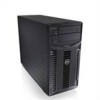Dell PowerEdge T410 Hardware Owner's Manual - Page 44
Alert! Redundant, Alert! Power - memory installation
 |
View all Dell PowerEdge T410 manuals
Add to My Manuals
Save this manual to your list of manuals |
Page 44 highlights
Table 1-3. System Messages (continued) Message Causes Corrective Actions Alert! Node Interleaving disabled! Memory configuration does not support Node Interleaving. The memory configuration Ensure that the memory does not support node modules are installed in a interleaving, or the configuration that supports configuration has changed node interleaving. Check (for example, a memory other system messages for module has failed) so that additional information for node interleaving cannot be possible causes. For memory supported. The system configuration information, continues to run, but without see "General Memory node interleaving. Module Installation Guidelines" on page 106. If the problem persists, see "Troubleshooting System Memory" on page 162." Alert! Power required exceeds PSU wattage. Check PSU and system configuration. Alert! Continuing system boot accepts the risk that system may power down without warning. The system configuration of processor(s), memory modules, and expansion cards may not be supported by the power supplies. If any system components were just upgraded, return the system to the previous configuration. If the system boots without this warning, then the replaced component(s) are not supported with this power supply. If Energy Smart power supplies are installed, replace them with High Output power supplies to use the components. See "Power Supplies" on page 121. Alert! Redundant memory disabled! Memory configuration does not support redundant memory. Memory Sparing or Memory Check the memory modules Mirroring was enabled in the for failure. See system setup program, but "Troubleshooting System the current configuration Memory" on page 162. Reset does not support redundant the memory setting, if memory. A memory module appropriate. See "Using the may be faulty. System Setup Program and UEFI Boot Manager" on page 61. 44 About Your System















